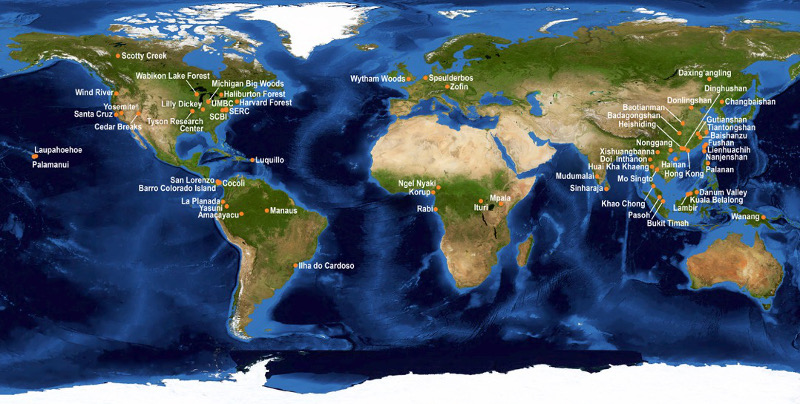Satellites Detect the Healthy Glow of a Forest With Underground Friends
Just as a person’s skin indicates if s/he has a healthy diet, colored satellite images of forests in the Smithsonian’s Forest Global Earth Observatory (ForestGEO) indicate if a forest has a healthy diet. Information about the trees’ access to nutrients based on its relationships with two different types of underground fungi is now detectable from space, making it possible for scientists to measure ecosystem productivity and responses to environmental change on vast scales.
“Every tree species has a distinct spectral signal, a kind of measurable aura,” said Sean McMahon, temperate program coordinator of the ForestGEO network. “Now we can tell who their underground friends are, an indicator of their nutrient status, from the sky.”
Trees form beneficial relationships with soil fungi. The thread-like hyphae of the fungi spread out like a huge net through the soil, helping trees gather water and nutrients in exchange for sugars made by the trees’ photosynthesis. Joshua Fisher from NASA’s Jet Propulsion Laboratory and UCLA and his colleagues developed a way to detect and map the associations between forests and fungi.
They compared Thematic Mapper radiance data from Landsat satellites with traditional data about fungal associations of different species from 130,000 individual trees in long-term forest-monitoring plots at the Smithsonian’s Conservation Biology Institute in Virginia, the Lilly-Dickey Woods in Indiana, Wabikon in Wisconsin’s Chequamegon-Nicolet Forest and at the Tyson Research Center in Missouri.
“We discovered that groups of tree species associating with one type of fungi were spectrally distinct from groups of species associating with other types of fungi,” Fisher said.
Based on the spectral data, they could tell whether trees formed associations with ectomycorrhizal fungi (ECM), that only grow on and around root cells, or arbuscular mycorrhizal fungi (AM), which penetrate the cells. Scientists knew which tree species associate with which fungi, but would have been impossible to map every single tree across landscapes or continents by hand.
Fungal associations indicate complex processes that are much harder to get a handle on.
AM-associated trees usually have higher leaf phosphorus content, leaf out earlier and quickly decomposing leaf litter, resulting in faster nutrient cycling. ECM-associated trees are usually characterized by slower nutrient cycling. AM-associated trees are more common in the tropics, and ECM trees in boreal forests, but temperate forests have a mix of both. The mycorrhizal association also depends on land-use history.
Maples, tulip poplars and white ashes are all unique species with unique spectral signatures, and they all only associate with AM fungi. Oaks, American beeches, and hickories only associate with ECM fungi. Fisher and colleagues asked whether there are spectral signatures in common among the first group that differ from spectral signatures in common among the second group. Based on their observations they were able to predict 77 percent of the variation in mycorrhizal distribution within the forest plots.
Researchers in the 30-year-old ForestGEO network have accumulated an enormous amount of knowledge from forests around the world. In addition to studying the relationship between tree species and fungi, they map and measure more than six million individual trees at five-year intervals, take data on seasonal changes and measure leaf spectral properties using canopy cranes and drones, airplanes equipped with LiDAR technology and other tools that allow information to be integrated from local scales up to global scales.
The team will extend the analysis to more of the 63 research plots in the Smithsonian’s ForestGEO network where scientists use the same methods, making the global comparisons needed to understand climate change, pollution and deforestation and reforestation possible.
The authors are affiliated with the Smithsonian Conservation Biology Institute, the National Zoological Park; the Jet Propulsion Lab at the California Institute of Technology; the Joint Institute for Regional Earth System Science and Engineering at the University of California, Los Angeles; the Center for the Study of Institutions, Populations and Environmental Change at Indiana University; the Department of Biology, West Virginia University; the Department of Geography, Indiana University, the Yale School of Forestry and Environmental Studies; the Department of Biology, Washington University; the Conservation Ecology Center; the U.S. Geological Survey, National Research Program-Eastern Branch; the Department of Natural and Applied Sciences and Cofrin Center for Biodiversity, University of Wisconsin, Green Bay; and the Department of Biology, Indiana University.
# # #
Fisher, J.B., Sweeny, S., Brzostek, E.R., Evans, T.P., Johnson, D.J., Myers, J.A., Bourg, N.A., Wolf, A.T., Howe, R.W., Phillips, R.P. 2016. Tree-mycorrhizal associations detected remotely from canopy spectral properties. Global Change Biol. onlinelibrary.wiley.com/doi/10.1111/gcb.13264/full
SI-218-2016
Beth King
202-633-4700 x 28216

